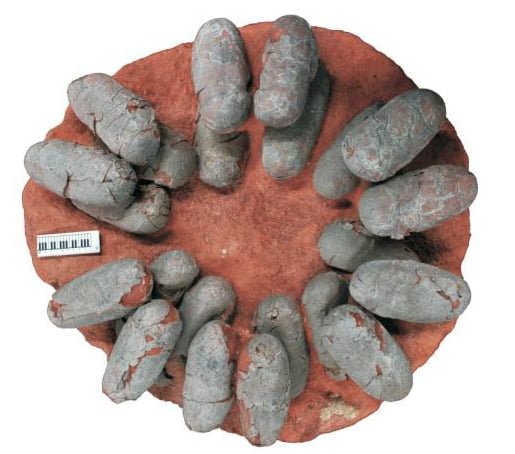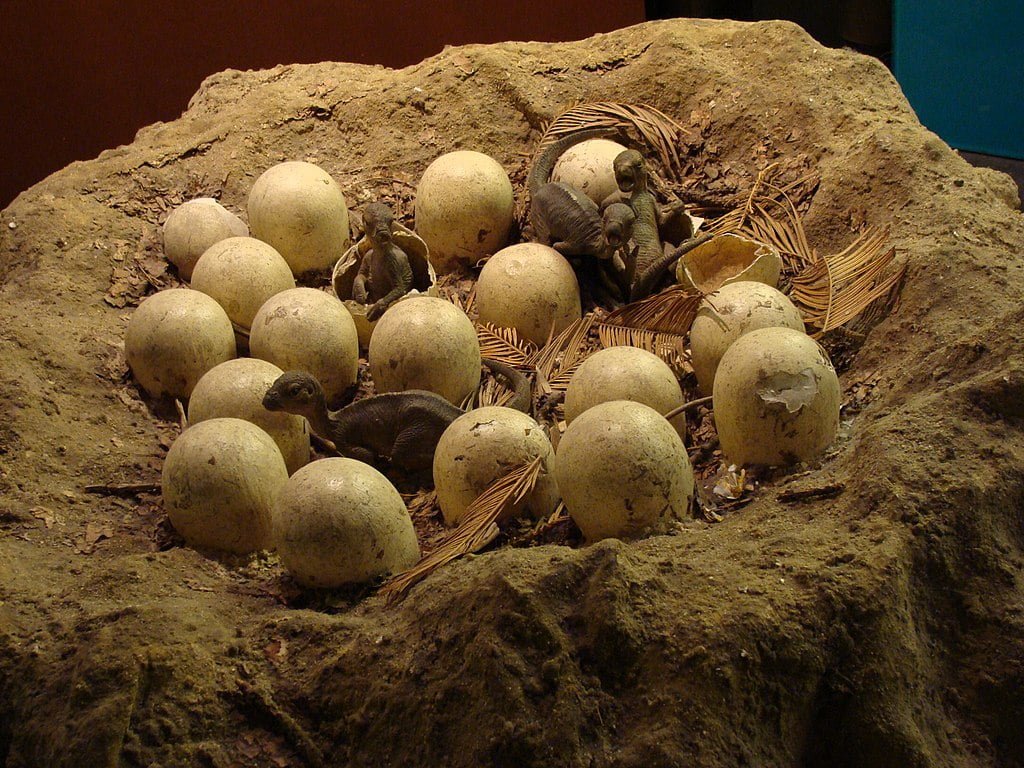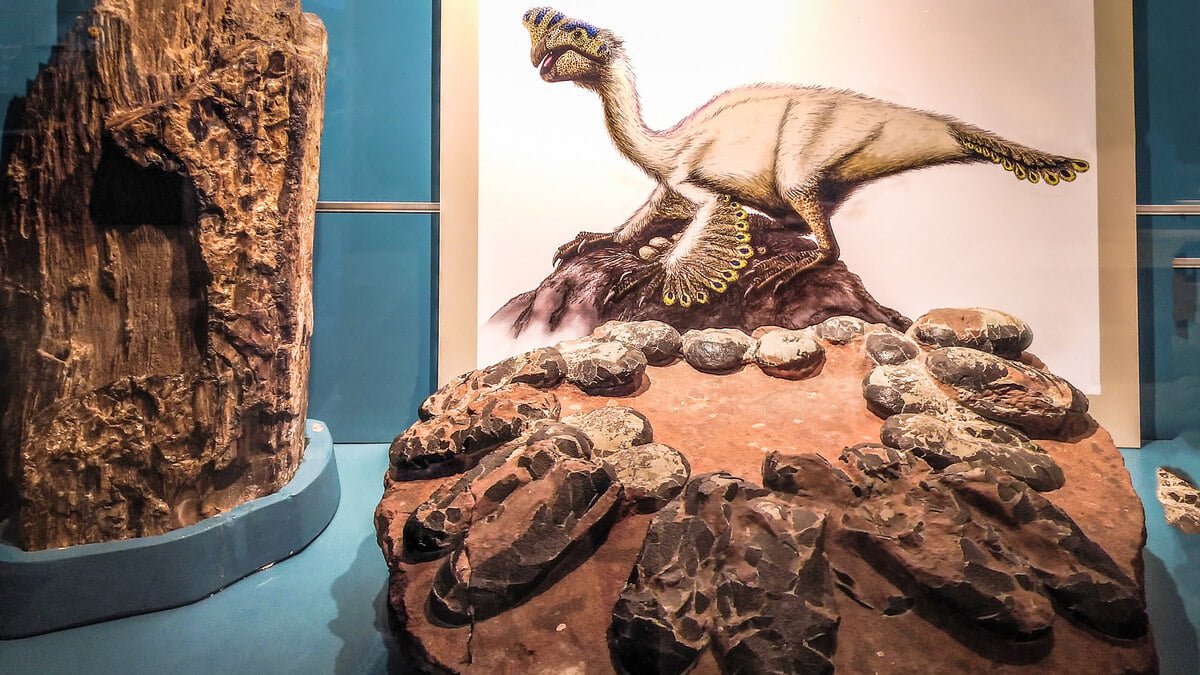Which came first, the dinosaur or the egg? The answer is, of course, the egg. The hard-shelled eggs we know today first evolved around 312 million years ago! Did dinosaurs lay eggs?
Dinosaurs did not first appear until 230-240 million years ago. How do we know that dinosaurs laid eggs? How could something so big take care of something so fragile?
All dinosaurs laid eggs. Though dinosaurs were the largest land animals to ever exist, they hatched from eggs no larger than a watermelon. Dinosaur nests provide rich information about behavior and growth patterns and are very exciting for paleontologists.
Just what is so exciting about dinosaur nests? Let’s explore eggs in more detail and see how they provide clues about dinosaur behavior.
What Makes an Egg?
Before shells, eggs were laid in the water so that gases and water could reach the embryo inside the egg. To move onto land, animals had to evolve amniotic eggs. These eggs have hard or leathery shells that only let gases pass through.
Water and other fluids are already inside the egg. When the embryo finishes using these fluids and nutrients to grow, it hatches. Today, the group of animals that have amniotic eggs includes reptiles, birds, and mammals.
Yes, mammal eggs have all the same parts as bird or reptile eggs without shells. If you’re shocked to learn that mammals lay eggs, check out this article from wildlifeinformer.com that showcases five modern mammals that lay eggs.
Answers to The Question: Did Dinosaurs Lay Eggs
Millions of years ago, this group also included dinosaurs! We know that dinosaurs laid eggs because we have fossil eggs from dinosaurs. Pretty compelling, eh?
The first fossil eggs were found in 1923. These belonged to the Late Cretaceous dinosaur Oviraptor. Before that, pieces of dinosaur eggshells were thought to be from giant birds.
Some of the earliest dinosaur eggs we have found come from the Late Triassic or Early Jurassic. They belong to Mussaurus and Qianlong. These eggs were leathery instead of hard-shelled.
Some eggs even include the fossils of embryos inside the eggs. The oldest dinosaur egg with an embryo comes from Massospondylus, which existed around 190 million years ago.
What Can Scientists Learn From Eggs?
Paleontologists look inside fossil eggs using CAT scans or by dissolving the shell with acid. Dinosaurs laid eggs in all shapes, sizes, colors, and textures. All these differences can tell us how each dinosaur took care of its eggs.
Round, spherical eggs were probably buried underground where they would not be in danger from rolling around. Oblong, oval eggs could be kept in open nests because they would not roll out.
The colors of the eggs mostly had to do with camouflage, but may have also been a way for different dinosaurs to recognize different species of eggs. Soft, leathery eggs would not do well with heavy parents sitting on them, but hard-shelled eggs could survive the weight in some cases.

What does this mean? This suggests some parents kept a closer eye on their eggs than others. We’ll get to this a bit later.
Just like modern animals, different dinosaurs laid different numbers of eggs too. Some species laid one or two and others laid one or two dozen. Psittacosaurus laid up to 34 eggs at a time!
When is an Egg Not an Egg?
There are lots of fossils or rocks that get mistaken as fossil eggs, especially dinosaur eggs. These can be found anywhere, like rocks that are rounded like an egg. Sometimes these are found right next to dinosaur fossils, like gastroliths.
A gastrolith is a rock that is swallowed to help break down food in the stomach. They could be any shape, but often became rounded over time and may look like an egg. If you’re curious, we have a full article that discusses why dinosaurs ate rocks.
Some egg lookalikes are made by modern animals. Just like a kidney stone, chemicals can build up and solidify in the stomach. These are especially common in ruminants like deer, cows, or goats because of their special digestive system.
These lookalikes can become covered in calcium before the animal throws it up. This solid, round object with a calcium shell both looks and sounds like an egg, and it is very easy for even scientists to get them confused.
How Did Dinosaurs Raise Their Young?
You might wonder, how can huge animals like dinosaurs lay equally giant eggs? The truth is, they didn’t.
Even the biggest of dinosaurs laid relatively small eggs. The biggest sauropods could grow over 100 feet (30 meters) long but they were no bigger than geese when they hatched. Big dinosaurs start small, but grow very quickly! It only took around 30 years for a sauropod to grow 10,000 times bigger than it was when it hatched.
The size of the dinosaur and the size of the egg don’t always match up, either. The smallest dinosaur egg ever found is about 2 inches (5 centimeters) long and the largest is about 24 inches (61 centimeters) long. Both of these eggs were laid by theropods, which come in a wide range of sizes but never compared to sauropods in size and weight.
For more on dinosaur eggs, check out adventuredinosaurs.com. They cover some rarely discussed dinosaurs in this article.
Paleontologists can look at the eggs themselves to figure out how dinosaurs raised their young. They can also look at some dinosaurs that are fossilized with their young.
Take the Maiasaura, for example. This dinosaur’s name means “good mother lizard.” A fossil nesting colony was found that includes eggs, embryos, and also young dinosaurs. A model nest is pictured below.

Adult Maiasaura made large groups of nests where eggs were arranged in circles and then covered in rotting plants. These plants incubated the eggs so that the parents did not have to sit on them. This is a good thing too because adult Miasaura weighed around 4.4 tons (4 metric tons)!
The young Maiasaura fossils in the nest have already worn teeth and not-yet-developed legs. This shows that the adults were feeding the young before they could leave the nest.
Oviraptorids were also very active parents. Oviraptor means “egg thief.” They were given this name because so many fossils were found with eggs.
At first, paleontologists thought they were eating them. Later finds have shown Oviraptor sitting on the eggs just like birds do, proving that they were taking care of nests and not stealing from them.
Another oviraptorid, Citipati, was found sitting on top of 12 eggs with its wings spread over them to protect them. This behavior is just like that observed in most modern birds.
Dinosaur Eggs Remain One of The Most Telling Fossil Discoveries
We often think of dinosaurs as scary, cold-hearted predators. Those that weren’t were seen as just giant leaf-eating machines. They’re rarely portrayed as caring parents.
When you stop to think about it, it’s no surprise that dinosaurs acted this way. After all, the only remaining are still laying eggs, building nests, and guarding them today (with few exceptions). Dinosaur eggs provide a wealth of information about dinosaur behavior and growth patterns.
As far as we know, all dinosaurs laid eggs. These eggs have yielded some fantastic information about these wonderful creatures.
Did you learn something new today? Leave us a comment to share your thoughts. If you find this type of content helpful, please share it with your friends so that they can learn too.

